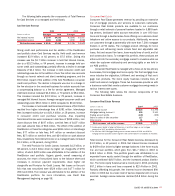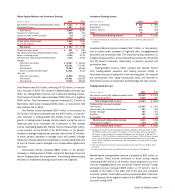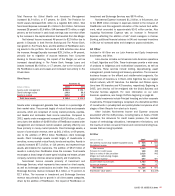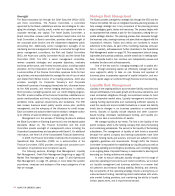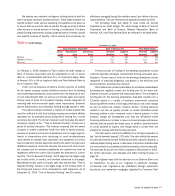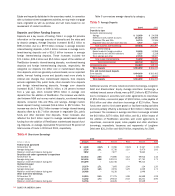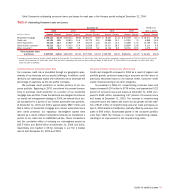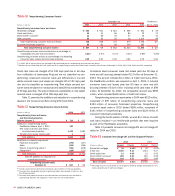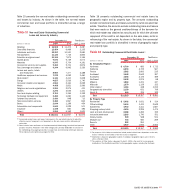Bank of America 2004 Annual Report Download - page 54
Download and view the complete annual report
Please find page 54 of the 2004 Bank of America annual report below. You can navigate through the pages in the report by either clicking on the pages listed below, or by using the keyword search tool below to find specific information within the annual report.
BANK OF AMERICA 2004 53
We develop and maintain contingency funding plans for both the
parent company and bank liquidity positions. These plans evaluate our
liquidity position under various operating circumstances and allow us
to ensure that we would be able to operate through a period of stress
when access to normal sources of funding is constrained. The plans
project funding requirements during a potential period of stress, specify
and quantify sources of liquidity, outline actions and procedures for
effectively managing through the problem period, and define roles and
responsibilities. They are reviewed and approved annually by ALCO.
Our borrowing costs and ability to raise funds are directly
impacted by our credit ratings. The credit ratings of Bank of America
Corporation and Bank of America, National Association (Bank of
America, N.A.) and Fleet National Bank are reflected in the table below.
On February 1, 2005, Standard & Poor’s raised its credit ratings on
Bank of America Corporation and its subsidiaries to AA- on senior
debt, A+ on subordinated debt and A-1+ on commercial paper; Bank
of America, N.A. to AA on long-term debt; and Fleet National Bank to
AA on long-term debt.
Under normal business conditions, primary sources of funding
for the parent company include dividends received from its banking
and nonbanking subsidiaries, and proceeds from the issuance of sen-
ior and subordinated debt, as well as commercial paper and equity.
Primary uses of funds for the parent company include repayment of
maturing debt and commercial paper, share repurchases, dividends
paid to shareholders, and subsidiary funding through capital or debt.
The parent company maintains a cushion of excess liquidity that
would be sufficient to fully fund holding company and nonbank affiliate
operations for an extended period during which funding from normal
sources is disrupted. The primary measure used to assess the parent
company’s liquidity is the “Time to Required Funding” during such a
period of liquidity disruption. This measure assumes that the parent
company is unable to generate funds from debt or equity issuance,
receives no dividend income from subsidiaries, and no longer pays div-
idends to shareholders while continuing to meet nondiscretionary
uses needed to maintain bank operations and repayment of contrac-
tual principal and interest payments owed by the parent company and
affiliated companies. Under this scenario, the amount of time the par-
ent company and its nonbank subsidiaries can operate and meet all
obligations before the current liquid assets are exhausted is consid-
ered the “Time to Required Funding”. ALCO approves the target range
set for this metric, in months, and monitors adherence to the target.
Maintaining excess parent company cash that ensures that “Time to
Required Funding” remains in the target range is the primary driver of
the timing and amount of the Corporation’s debt issuances. As of
December 31, 2004 “Time to Required Funding” was 29 months.
Primary sources of funding for the banking subsidiaries include
customer deposits, wholesale market-based funding, and asset secu-
ritizations. Primary uses of funds for the banking subsidiaries include
repayment of maturing obligations, and growth in the ALM and core
asset portfolios, including loan demand.
ALCO determines prudent parameters for wholesale market-based
borrowing and regularly reviews the funding plan for the bank sub-
sidiaries to ensure compliance with these parameters. The contingency
funding plan for the banking subsidiaries evaluates liquidity over a
12-month period in a variety of business environment scenarios
assuming different levels of earnings performance and credit ratings
as well as public and investor relations factors. Funding exposure
related to our role as liquidity provider to certain off-balance sheet
financing entities is also measured under a stress scenario. In this
analysis, ratings are downgraded such that the off-balance sheet
financing entities are not able to issue commercial paper and backup
facilities that we provide are drawn upon. In addition, potential draws
on credit facilities to issuers with ratings below a certain level are
analyzed to assess potential funding exposure.
One ratio used to monitor the stability of our funding composition is
the “loan to domestic deposit” (LTD) ratio. This ratio reflects the percent
of Loans and Leases that are funded by domestic customer deposits, a
relatively stable funding source. A ratio below 100 percent indicates that
our loan portfolio is completely funded by domestic customer deposits.
The ratio was 93 percent for 2004 compared to 98 percent for 2003.
For further discussion, see Deposits and Other Funding Sources on
page 54.
We originate loans both for retention on our Balance Sheet and
for distribution. As part of our “originate to distribute” strategy,
commercial loan originations are distributed through syndication
structures, and residential mortgages originated by Consumer Real
Table 4
Credit Ratings
December 31, 2004
Bank of America Corporation Bank of America, N.A. Fleet National Bank
Senior Subordinated Commercial Short-term Long-term Short-term Long-term
Debt Debt Paper Borrowings Debt Borrowings Debt
Moody’s Aa2 Aa3 P-1 P-1 Aa1 P-1 Aa1
Standard & Poor’s A+ A A-1 A-1+ AA- A-1+ AA-
Fitch, Inc. AA- A+ F1+ F1+ AA- F1+ AA-


